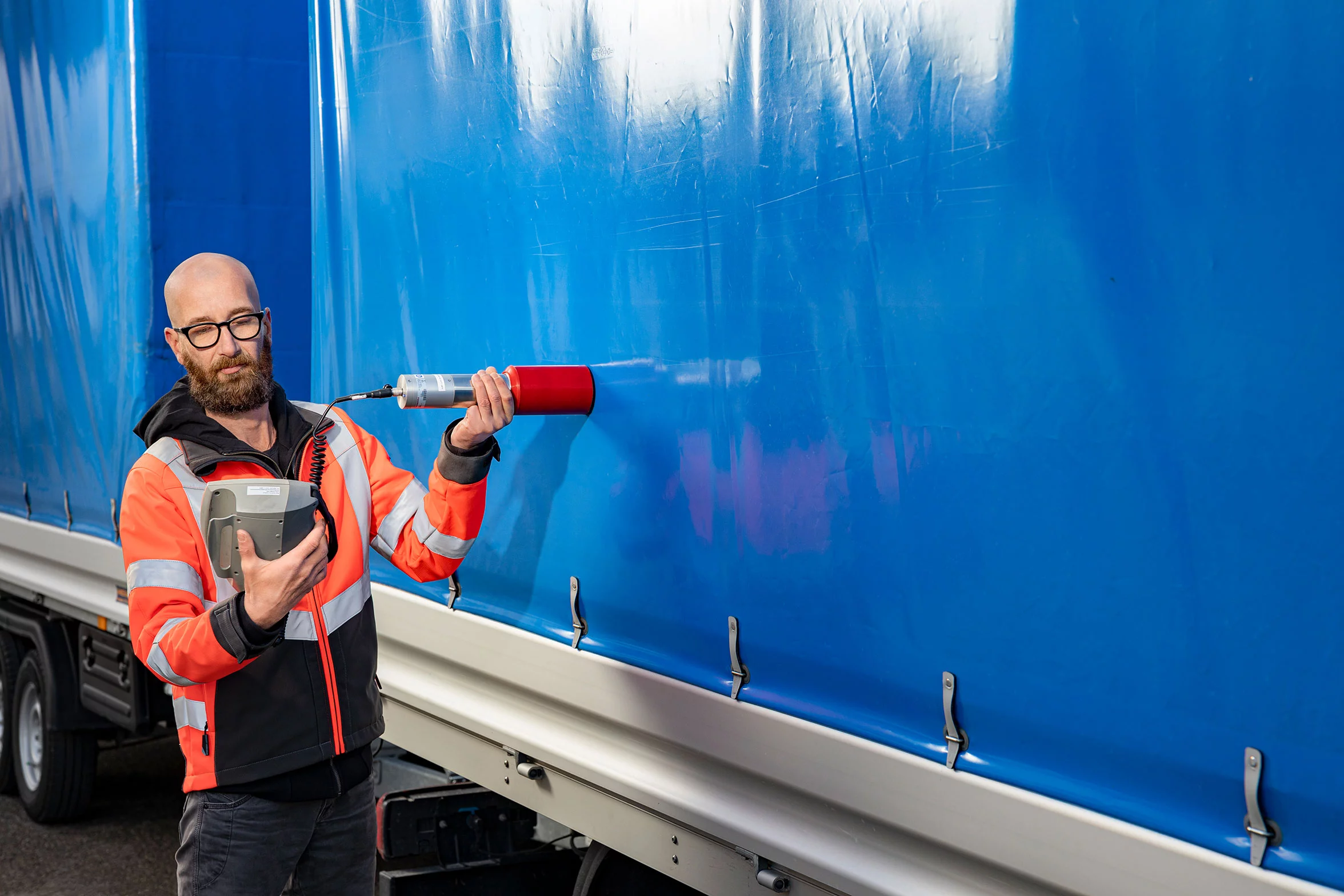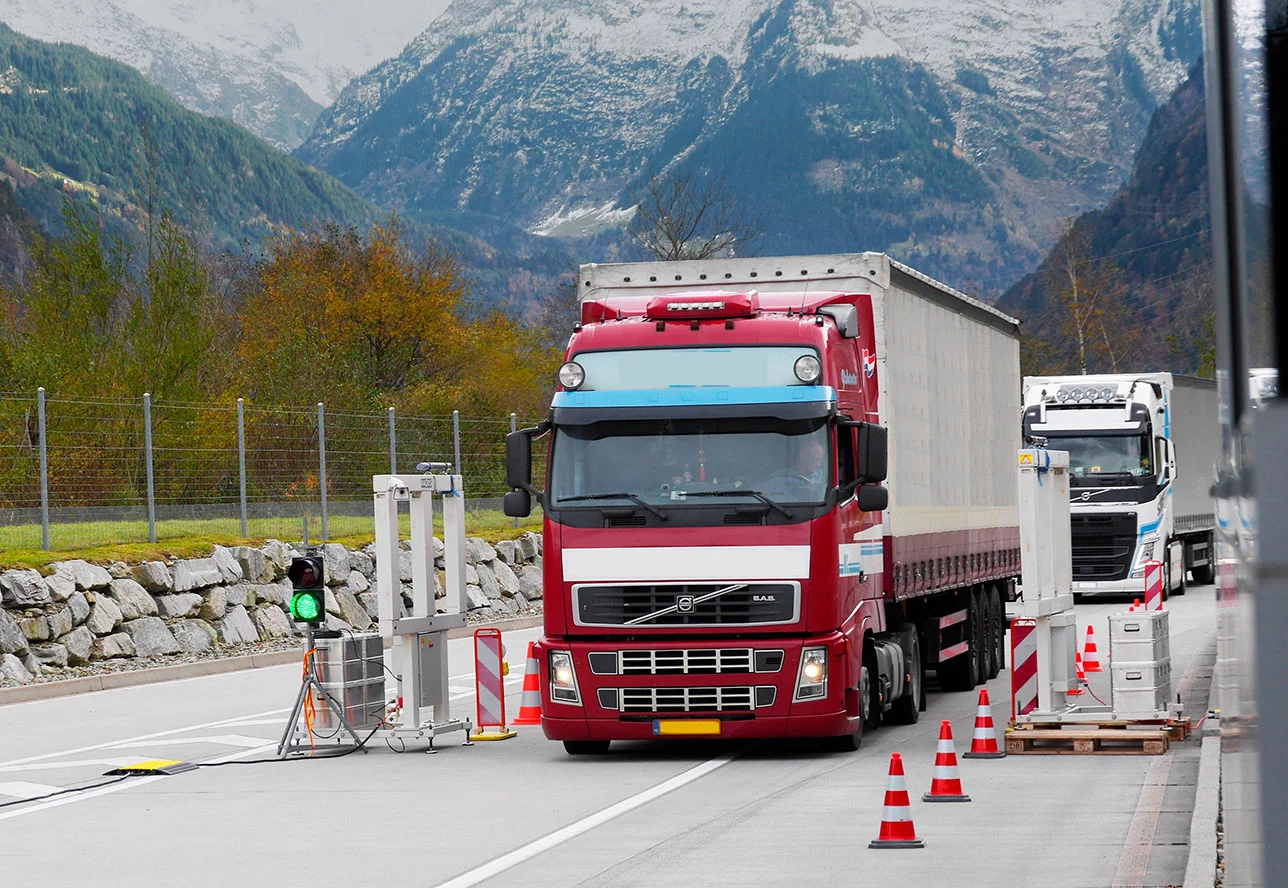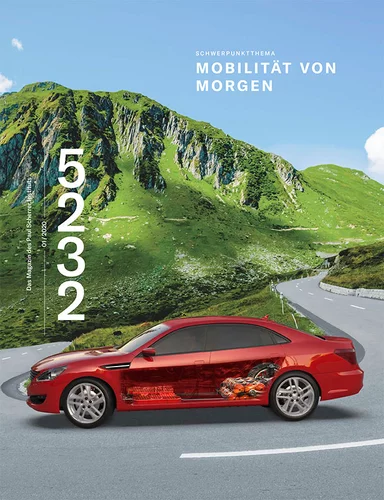With a mobile measurement portal, PSI regularly carries out radioactivity checks on large goods vehicles. The purpose of this work, on behalf of the Swiss Federal Office of Public Health, is to discover unidentified radiation sources. Naturally occurring radioactive material can also trigger an alarm and surprise the PSI team.
Just now a lorry with cement is driving through the portal that Udo Strauch and Rouven Philipp from PSI spent three hours installing, in the heavy goods transport centre in Erstfeld. In the transport container they brought with them, which now serves as an office, they can follow on the computer screen what detectors in the six white columns to the left and right of the lorry measure: gamma rays emanating from radioactive material. Because the natural environment also constantly emits low levels of radiation, the level can actually drop when a lorry passes through the measurement portal because it partially shields the background radiation. Not so in the case of this cement mixer, and that triggers an alarm.
"This happens pretty often," explains Udo Strauch. "Like all materials obtained from the crust of our Earth, cement can contain small proportions of naturally occurring so-called radionuclides, which emit gamma radiation." Such goods include, for example, rocks such as granite, crushed stone, mineral sand, and fertilizers, which contain more or less radioactive material depending on their origin, processing method and quantity. Often the proportions are negligible, so that they would not be detectable if a load were only as large as the contents of a conventional gym bag. "But if a lorry is carrying a load of 22 tons, it will be measurable in our portal," Strauch says.
Because the portal monitor sets off an alarm inside the container, the cement mixer is stopped. The PSI expert walks around the vehicle and uses a handheld measuring device to check the load area. The radiation level is slightly elevated, but evenly and everywhere. If Strauch found a clear radiation maximum somewhere, he would get out another measuring device. That one can be used to determine which radionuclides are causing the gamma radiation. However, the cement mixer does not exceed the limits for naturally occurring radioactive materials. Therefore, the driver can continue his journey. "The alarm messages show that our measuring devices are working, even if the limits for natural radionuclides have never yet been exceeded in our checks of such loads," says Strauch.
Radioactive scrap metal
Yet there have been some quite alarming examples of threatening materials in goods transport. For example, four radioactive sources have been discovered in the ports of Hamburg and Rotterdam since November 2018, such as substances used for radiation in medicine or the food industry. These cobalt-60 sources are highly radioactive. They were in containers with scrap metal and were tracked down thanks to measurement portals, as reported by the International Atomic Energy Agency IAEA. In Hamburg, a shiny, ten-centimetre long metal cylinder was found packed in a cloth sack. That delivery of scrap metal came from West Africa. It was not possible to determine where the cobalt-60 sources found in the Netherlands had come from. Fortunately, it was possible to safely recover and store the extremely dangerous material without harming anyone.
Stainless steel products contaminated with cobalt-60 also made it into Switzerland at the end of 2008. Apparently, a source had gotten into recycling material processed by a smelting plant in India. Among other things, lift buttons had been made from the steel. "This had to be disposed of as radioactive waste because the permissible exemption limit was exceeded," says Reto Linder from the Federal Office of Public Health FOPH: "This and other events, such as possible imports of goods contaminated after the Fukushima reactor disaster, prompted the introduction of focused periodic measurements." Checks for radioactivity have been carried out regularly since 2015. With the revision of the Radiation Protection Ordinance of 2018, the FOPH was commissioned to organise periodic focus checks on the import, export and transport of goods.
"This demand is based, among other things, on recommendations from IAEA and EU guidelines," explains Linder. The United States, in particular, had insisted on it because of the threat of terrorism. Dirty bombs containing radioactive material could have a devastating effect. But lost radiation sources, which can surface anywhere due to the global scrap metal trade, also pose a danger to people and the environment. "The probability that stray radioactive material will be discovered is certainly higher; but the smuggling of radioactive material cannot be ruled out either, and discovering it is also a goal of these checks," says Linder.
On behalf of the FOPH, Udo Strauch and Rouven Philipp set up the mobile portal several times a year at various locations, such as a border crossing or in a monitoring centre for heavy goods transport. They carry out radioactivity measurements there for one week, often with the help of representatives of the FOPH and with the help of the Federal Customs Administration and the police. "We carry out a risk analysis that shows where checks make the most sense," explains David Marquis of the Federal Customs Administration: "On the basis of this risk analysis, we coordinate the cooperation between our staff at the customs offices and border guards with the partner organisations PSI and FOPH. We support the experts on site in carrying out the checks, for example by stopping vehicles." So far, PSI has taken part in checks throughout Switzerland at 15 different locations, including the heavy goods transport centre in Erstfeld and at the Basel, Chiasso and Kreuzlingen border crossings.
Tobacco set off an alarm
Udo Strauch is happy about the helpfulness and great interest shown by the customs officers and police. Many lorry drivers want to know why they are being checked and what is being measured. "This is sometimes surprising even for us," says Strauch. The team was amazed when they checked a lorry after it triggered an alarm and discovered that it was loaded with tobacco. The handheld measuring device indicated that the alarm had been set off by potassium-40. The element potassium, which is vital for all organisms, naturally contains this radioactive isotope. The large amount of dried plant material the tobacco lorry was carrying made the potassium-40 portion clearly measurable. "However, this is not dangerous, at least for non-smokers," affirms Strauch.
Waste and soils contaminated with radioactive substances such as radium, which was previously used mainly as luminous paint in the watch industry, are certainly a threat. That is why it is not only the transport of goods by road that must be monitored. Beginning in 2021, all waste incineration plants and recycling companies in Switzerland must also carry out inspections of incoming material. The PSI team has tested what to expect in a waste incineration plant. Rouven Philipp still remembers that day in midsummer when a garbage truck with ten tons of household waste triggered an alarm while passing through the mobile measurement portal. "It was our first find exceeding the limit," says Philipp. "The load had to be dumped and separated to locate the source." After three quarters of an hour, the team had discovered the rubbish bag they were looking for. The handheld measuring device indicated that gamma radiation was coming from a radioactive substance used in medical technology. Presumably, after a nuclear medicine treatment, a patient had thrown away hygiene articles at home that still contained residues of the radionuclide, making professional disposal necessary.
Text: Barbara Vonarburg



